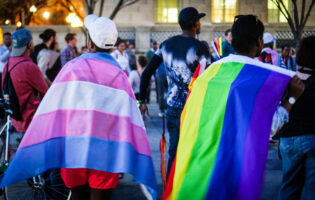Still a Berliner?

Julia Lange
University of Hamburg
Julia Lange is a PhD candidate at the University of Hamburg, Germany and was a Visiting Fellow at AICGS in 2013-2014. In her dissertation, supervised by Prof. Dr. Susanne Rohr, she examines the interrelation between the politics of memory of German-American institutions and the Holocaust discourse on both sides of the Atlantic. The primary focus of her work is on transnational discourses of victimization and reconciliation and the dynamics of the competing memories that have been produced by German-American and Jewish-American organizations since the end of the Second World War.
Ms. Lange has recently published a book entitled Herman the German: Das Hermann Monument in der deutsch-amerikanischen Erinnerungskultur (LIT Verlag) in which she examines the changing function of the German “Hermannsdenkmal” and its American equivalent, the Hermann Monument in New Ulm, Minnesota from the late nineteenth to the beginning of the twentieth-first century. Both monuments commemorate Arminius the Cherusci and the Germanic victory over three Roman legions at the Battle of the Teutoburg Forest in 9 AD, a battle which later became hailed as a German founding myth with the rise of German nationalism in the nineteenth century. Ms. Lange’s study explores not only how German-American identity is both shaped by and reflected in the meanings ascribed to the Hermann Monument, but also why its history of reception significantly differs from the monument’s German counterpart in North Rhein-Westphalia.
Ms. Lange studied American Studies, English Literature, and Law at the University of Hamburg and the University of Oxford. After receiving her Masters of Arts in 2011, she was a Visiting Fellow at the Department of Germanic Languages and Literatures at Harvard University in 2012, followed by a Visiting Scholarship in the Department of Germanic Languages at Columbia University in 2013. Ms. Lange is currently a scholar with the German National Academic Foundation and has previously been awarded a scholarship in the European Excellence Program of the German Academic Exchange Service (DAAD).
On June 26, 1963, one million people lined the streets of Berlin and enthusiastically greeted President John F. Kennedy as he traversed the city on his way to Mayor Willy Brandt’s residence. He was riding in the very same blue convertible in which he would be killed only five months later in Dallas, Texas on November 22, 1963. At the Rathaus Schöneberg, in one of his—arguably—best-known speeches,Kennedy assured West Berlin of the United States’ continued support and uttered his famous words “Ich bin ein Berliner.” Just a few miles away, blocked from Kennedy’s sight by a red curtain with the emblem of the German Democratic Republic (GDR) that had been installed at the Brandenburg Gate by East German authorities on the occasion of the U.S. president’s visit to prevent unwanted panoptic intrusion, the Ministry for State Security was recording East Germans’ reactions to Kennedy’s speech. Little did they expect that five months later they would find themselves in similar circumstances, this time, however, tracking public responses to President Kennedy’s assassination.
Whereas in the United States, on the eve of his tragic death on November 22 in Dallas, Kennedy had been gradually falling out of favor among a significant segment of the American public due to his policy of détente toward the Soviet Union and his stand on civil rights, he enjoyed unprecedented popularity and support in West Germany. Embodying youth, vitality, and the promise of a new and better world, his charismatic appearance contrasted sharply with that of the respectable, but elderly, German Chancellor Konrad Adenauer. Kennedy’s celebrated visit to Berlin only perpetuated many Germans’ image of the U.S. president as a modern savior in an ideologically divided world.
Therefore, the shock was deep when news of his assassination reached West Berlin in November 1963. Recourse to historical analogies was a viable strategy for those trying to explain the political significance of the event. In a memorial speech, broadcast on German radio and television late on November 22, President of the German Bundestag Eugen Gerstenmaier compared John F. Kennedy’s assassination to Abraham Lincoln’s, whom he credited with ending slavery one hundred years prior to Kennedy’s death. The German press picked up on the comparison, in some cases even suggesting that Lincoln had been assassinated a second time in the person of JFK. Other European newspapers emphasized the potentially disastrous repercussions of the event by drawing comparisons to Archduke Franz Ferdinand of Austria’s assassination that had triggered the First World War.
Voices that framed Kennedy’s death in the logic of the Cold War were equally prominent. German Chancellor Ludwig Erhard honored Kennedy as a friend, ally, and leader of the Western world. Georg Diederichs, Minister President of Lower Saxony, opted for a more martial rhetoric stylizing Kennedy as a martyr in a struggle between freedom and communism. Together with Mayor Brandt, Federal President Heinrich Lübke, and Foreign Minister Gerhard Schröder, Chancellor Erhard flew to the United States to attend the funeral proceedings at Arlington National Cemetery on November 25. Defense Minister Kai-Uwe von Hassel travelled separately by boat. Upon meeting Jacqueline Kennedy, she remarked to Brandt that her husband’s day in Berlin, of which he repeatedly spoke, had left a lasting impression on him.
Ironically, the three wreaths with ribbons in black, red, and gold that had been laid at Kennedy’s grave by the German delegation were removed by a cemetery keeper the morning after the burial. It turned out that an anonymous caller had contacted the cemetery administration pretending to speak on behalf of the German embassy and requested the ribbons of the wreaths to be removed. The ribbons were soon to be reinstalled, of course.
In addition to the presence of leading German state representatives at Kennedy’s grave in Arlington, politicians and the public at home were also expressing their sympathy and regret. Just three days after the U.S. president’s assassination, the square at Rathaus Schöneberg was renamed “John-F.-Kennedy-Platz.” In West Berlin hundreds of thousands of people assembled for torchlight processions; manifestations of mourning in East Berlin also occurred, although in a more subdued and less visible manner. Agents of the security police (Stasi) were painstakingly observing every detail of public reaction to Kennedy’s death, counting as many as forty-eight candles flickering on eastern Germans’ windowsills. Moreover, students at several high schools insisted on observing a minute of silence in honor of the murdered president. Officially, the Socialist Unity Party (SED) condemned the assassination as a vicious and despicable act and promoted the view that it was committed by racists and right-wing extremists. Western media’s speculations about a communist connection or a Cuban plot behind the assassination were dismissed and replaced by interpretations that centered on a fascist method at work in the murder.
On June 28, 1963, Soviet leader Nikita S. Khrushchev paid a visit to East Berlin. Although officially meant to celebrate the seventieth birthday of the head of the German Democratic Republic, Walter Ulbricht, Khrushchev’s trip to Berlin was in essence a counter-propagandistic move to replicate Kennedy’s visit in the Soviet Union’s own front yard. The procedures of Khrushchev’s day in Berlin were strikingly similar to those of Kennedy’s visit to the Western part of the city a few days earlier. Like Kennedy, Khrushchev rode in a convertible limousine generating the same images of cheering crowds as his American adversary. Like the U.S. president, the Soviet leader held a speech at a town hall, the Rotes Rathaus of East Berlin, with the obvious difference, of course, that, unlike Kennedy, Khrushchev praised communism and its successful adoption on German territory.
When the Soviet state learned of Kennedy’s death, its condemnation of the violent act was surprisingly outspoken. Having struck a deal with Kennedy on the Cuban missile crisis in the months before the president’s death, Khrushchev felt obliged to portray Kennedy as a more trustworthy politician than his state apparatus had previously done in order to salvage his political capital. Facing critique for his supposedly excessively lenient course in the Cuban affair, Khrushchev was intent on proving that his approach had been fruitful and had minimized the risk of an American attack on the Caribbean island. The mutual agreement, however, relied entirely on Kennedy’s good word. As a result, the Soviet propaganda machine promoted a more positive image of President Kennedy in the months preceding his assassination.1
When news of Kennedy’s death spread to the Soviet Union, the press was quick to condemn the assassination. Comparable to the media echo in the GDR, newspapers in the USSR unanimously attributed the crime to right-wing fascists and capitalist forces. The fact that the alleged assassin, Lee Harvey Oswald, had lived in Moscow for some time and was married to a Russian woman was downplayed. Later on, the explanation that Oswald was responsible for the murder gained currency and became the official dominant narrative. The assassin’s motives, however, continued to be tied to right-wing conspiracy theories, their ultimate popularity thus not subsiding.
Fifty years later, JFK—and his assassination—still looms large in the collective imagination on both sides of the Atlantic. Countless articles, books, and docudramas have been produced and broadcast on primetime television to mark the event. Several special exhibitions, such as at the Newseum in Washington, DC, were launched and numerous commemorative services held throughout the United States, although admittedly less so in Europe. Ireland, the country of the Kennedys’ ancestors, figured as a notable exception. On November 22, high-ranking officials attended a commemorative service at the John F. Kennedy Memorial Park and Arboretum in New Ross in southeast Ireland. Earlier this year in June, Ireland’s prime minister and close relatives of the assassinated U.S. president had lit an Irish eternal flame near the Kennedys’ ancestral home. It was the first time the Kennedy family had allowed the flame at John F. Kennedy’s burial plot in Arlington cemetery to be used to illuminate a flame at another memorial site.
In contrast, in Germany, high-profile public remembrances have been rather conspicuous in their absence. Whereas the fiftieth anniversary of Kennedy’s Berlin speech provided an occasion for substantial reflection on the path the country has taken since the 1960s and was commemorated with a number of events that generated widespread publicity, the most noted one arguably being Obama’s speech at the Brandenburg Gate on June 19, the anniversary of John F. Kennedy’s death has not received anywhere near the same attention in German political life. Essentially, there were only two, comparatively little noticed, public events that were held in the Federal Republic on the occasion of the anniversary of Kennedy’s assassination. On November 23, U.S. Consul General Kevin C. Milas and Minister President of Hesse Volker Bouffier attended a wreath-laying ceremony at the Paulskirche in Frankfurt, a site of memory, where John F. Kennedy had held one of his nineteen speeches during his visit to Germany in June 1963. On November 22, exactly at 7pm, the time of Kennedy’s death fifty years earlier, a group of people illuminated candles in front of Rathaus Schöneberg. Chairman of the Berlin regional group of the CDU Kai Wegener joined the event initiated by the Democrats Abroad of the American Democratic Party.
In light of the little attention given to the golden anniversary of Kennedy’s assassination in Germany, especially in comparison to the multiple lavish events staged in observance of Kennedy’s Berlin speech(es): What accounts for the discrepancy in JFK-related commemorative practices in 2013?
John F. Kennedy’s status in the German national imaginary has undergone significant changes in the past fifty years. Once revered as a figure of hope and change shortly before his death, he has subsequently been turned into a powerful symbol of Western democracy—and thus capitalism—during the Cold War, only to be transformed into a glamorized universal icon symbolizing freedom, democracy, and human rights in an—arguably—not so post-ideological era as some may have predicted or at least wished for in the aftermath of the fall of the Berlin Wall. The resurgence of nationalism that we are currently witnessing is reflected in the reception of John F. Kennedy’s assassination across the world.
Whereas in the United States his death fulfills the function of (re)asserting the continuity of American democracy and national identity by providing an occasion to remember a traumatic moment in American history that has been successfully and collectively overcome, no such political agenda is linked to Kennedy’s assassination in Europe. In Ireland, the commemorations emphasized the traditional close links between Ireland and the United States and raised awareness of the large impact Irish-Americans have made on American life. In contrast, in Russia, state-run media such as the TV channel vesti.ru (previously Russia-24), did not even mention John F. Kennedy’s assassination, thus continuing a Soviet tradition of relegating Kennedy to the margins of history.
The reason for Germany’s reticence regarding public commemorations of the golden anniversary of President Kennedy’s assassination is presumably that his death, tragic as it was, simply did not have enough severe political ramifications for the country. With Lyndon B. Johnson taking over, the Vietnam War continued, as did the Cold War. At the end of the day, Kennedy’s death had little impact on German collective identity − the past, in this respect, being mostly a foreign country. The fall of the Berlin Wall and German unification certainly brought back memories of Kennedy’s legendary visit to Germany in June 1963, his prophetic vision of a free and united Berlin finally becoming a political reality. The thirty-fifth U.S. president’s untimely death at the height of the Cold War, however, did not – and still does not – quite fit neatly into the narrative of a “new,” democratic, and united Germany. Unlike Kennedy’s personal life, German democracy, fortunately, has not come to an abrupt end (yet again).
What we can observe on a global scale is thus a tension between a pop-mythologized image of JFK that continues to pervade the transnational imaginary—fed by ongoing conspiracy theories and the “Camelot” myth that casts the Kennedys as American ”royalty” and only gets perpetuated by attempts at its deconstruction (one just has to think of the proliferation of stories on Kennedy’s amorous pursuits and delicate health in recent years)—and a fragmented, nationalistically-informed use of his image for differing political agendas, the ultimate aim of these invocations of his persona being the consolidation or reinvention of distinct national identities.
In other words, JFK serves as a projection screen that either affirms (national) values or challenges (cultural) hegemony, depending on which side of the, by now, multiple geopolitical curtains you stand on. Differently put, the transformations and permutations his image underwent in the last decades is a function of the dynamics of historical and cultural contexts and the respective political goals attached to these.
Having said that, is JFK still a “real” Berliner? One of the less noted continuities of JFK’s assassination has to do with a mere temporal coincidence, which, nonetheless, sheds some light on his political legacy. On December 14, 1961, in his Statement on the Establishment of the President’s Commission on the Status of Women, John F. Kennedy pointed out that, “Women are entitled to equality of opportunity for employment in government and in industry.” On November 22, 2005, precisely 42 years after the assassination of John F. Kennedy, Angela Merkel was elected the first female Chancellor of the Federal Republic of Germany.
1. Cf. Iwan Zwetkow, “Kennedy-Attentat: Eine sowjetische Perspektive”, Russland HEUTE, November 21, 2013, http://russland-heute.de/meinung/2013/11/21/kennedy-attentat_eine_sowjetische_perspektive_26965.html (accessed December 5, 2013).









